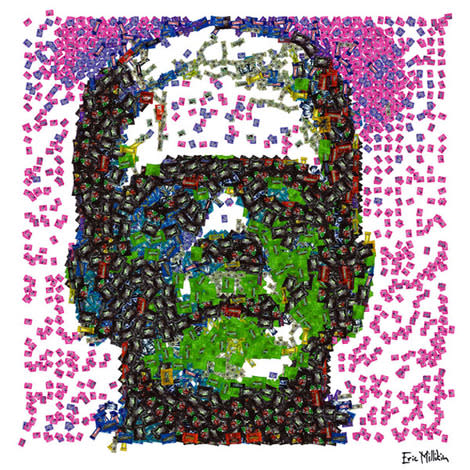What Else Can You Do with Halloween Candy? Make Amazing Portraits, of Course!

Eric Millikin, an experimental artist from Detroit, found a whole new use for Halloween candy, and it's pretty incredible. He's essentially reinvented portrait art using M&Ms, Kit-Kats and the like, all in honor of America's spookiest holiday.
Oh yeah, there's a spider hidden in each picture, if you can spot it.
We talked to Eric to get some insight into his delectable masterpieces.
What exactly is the canvas for your works of art, or do you just have a bunch of candy on your kitchen floor?
Eric: Yeah, my basic process is I start by eating a lot of candy until I get a huge sugar rush going, then I think really hard about monsters, then I lay some candy (that's uneaten candy, of course) down on the floor, and take photos of it in different arrangements. Then I mix up the candy and repeat.
Did you just one day sit in your chair and think, 'Hey, I should make monster faces out of Skittles?"
Eric: That's pretty close. I've been making big pictures out of little things for years, so the idea was probably forming over decades before it all came together in that "Eureka!" moment. You know, just like anybody, one day I'm building a cat out of mice, and I go: "What about monsters made from Halloween candy?" I always thought that if I was Andy Warhol, I would have built Marilyn Monroe out of soup cans, which I'll probably do someday, if I ever liked to eat soup.

Do certain sweets work better than others, and/or how do you know when to go with chocolate over fruity?
Eric: It's all by color. When I first started working on these, I'd get to points where I'd go, "I don't have enough shades of purple candies." And then I'd have to run to the store and buy a new kind of candy, whether I actually liked the taste of that candy or not. My favorite candy is actually black licorice, which I still haven't been able to find in a good fun size, so I haven't been able to use any. So, I guess what I am saying is that these works of art are great tragedies because I can't find any decent licorice.
What's up with the hidden spiders?
Eric: That's the question everyone seems to be asking! I thought it would be cool to have a sort of "Where's Waldo?" moment hidden in all those candies. I started thinking that it should be the one thing that a kid would not want to find in their treat bag. I thought maybe rocks, like Charlie Brown would get, or maybe dental floss. Neither of those sounded visually cool enough.
I see one picture used 5,000 pieces! How much candy do you average per photo?
Eric: I lost count long ago! 5,000 is probably about average… the Freddy Krueger portrait -- because it's one of the darkest -- probably has the most, probably way over 10,000 candies. But counting them would be a ... NIGHTMARE.

Do people at the grocery store think you're crazy for buying excessive amounts of candy?
Eric: Oh, yeah. As an artist, I'm used to getting strange looks at the grocery store, every time I have to make a late-night trip for the materials of some sculpture I'm working on. I have a lot of those moments where I realize: "It's 4 a.m., I'm the only person in the grocery store, and I'm buying a bag of Kit-Kats, a roll of duct tape, and a bottle of hair gel."
One of your interests is saving Detroit. Could these candy portraits be the way?
Eric: It seems like everyone's always saying Detroit needs saving, and then naming a politician or businessman they hope can do it. A giant Frankenstein made of chocolate bars probably has a better chance of saving Detroit than a lot of other things people have tried. If there's one thing that I've learned since Detroit has filed for bankruptcy, it's that the most valuable thing in Detroit is probably its artwork.
Ever thought about making the Mona Lisa out of Rolos? What would be the right candy to do Da Vinci?
Eric: Licorice! I'd build that Mona Lisa out of licorice if I could find any decent fun-size licorice in this town.
To see the full spread of Eric's work, click here.
